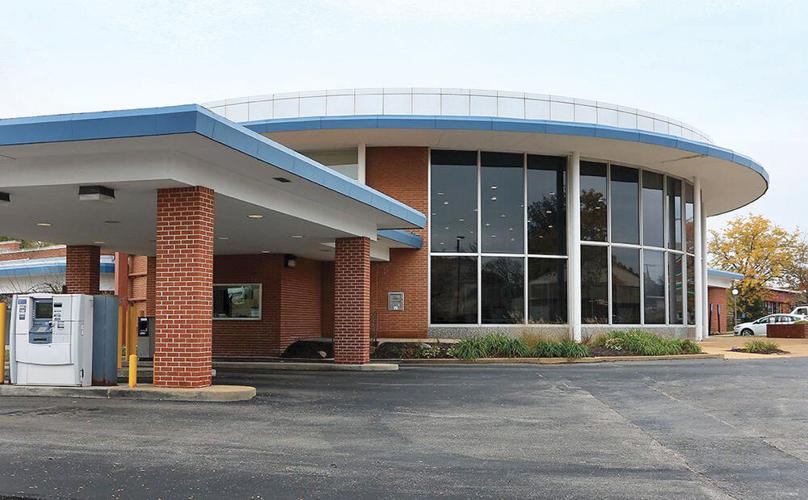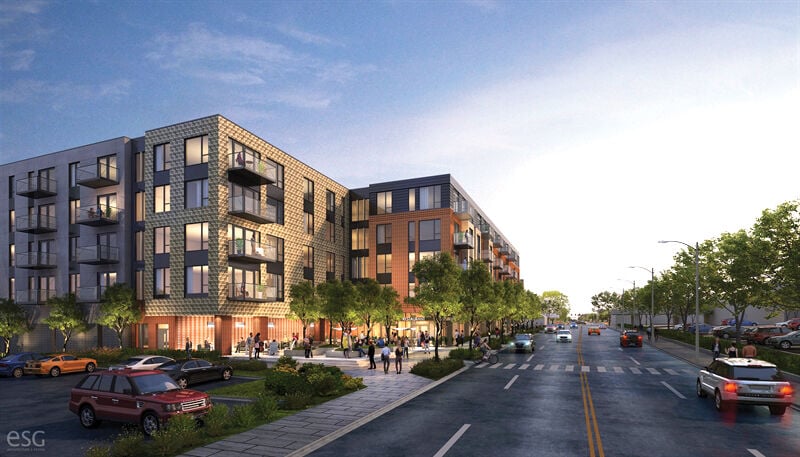Latest News

The United Missouri Bank building, 416 N. Kirkwood Road, will soon be demolished.
United Missouri Bank, 416 N. Kirkwood Road, could be demolished by the end of this month, or in early August, to accommodate “The James,” a 152-unit apartment building, according to Kirkwood Building Commissioner Jack Schenck.
Failed opposition to the residential development included a group of building preservationists who refer to the building as a “landmark.” They argued that the UMB circular structure represents “a very significant building,” with its extensive use of glass representative of modern architecture of the mid-1900s.
Though demolition is expected within weeks, Schenck said the developer, High Street Residential, has yet to apply for a demolition permit. A UMB branch has moved to a temporary location at 128 W. Washington Ave. and is open with regular hours.
It was in November of 2019 that the city of Kirkwood got its first look at plans for a six-story apartment building targeting the UMB location.
Since then, the development has gone through a name change — from Kirkwood Flats to The James — and was reduced from six to five stories. It also managed to weather opposition from citizens concerned about the building’s density and the increased traffic it may generate.

Artist’s rendering of The James, a major residential development approved for construction along North Kirkwood Road.
The Kirkwood City Council in September 2021 approved the development’s site plan. The James will rise five stories and will include 152 apartments and more than 7,000-square-feet of ground floor retail space. The suburban-urban development is slated to be completed in early 2024.
High Street Residential, the residential subsidiary of Trammell Crow Company, is the project’s developer. ESG Architecture & Design is serving as the architect and Brinkmann Constructors is the general contractor for the development.
“The James is situated on a site in Kirkwood that is distinctively ‘suburban urban,’ offering urban walkability and access to great amenities in a suburban location. This creates an environment that is a highly desirable feature for renters and one that crosses generational boundaries,” said Josh Udelhofen, senior vice president with High Street Residential’s Midwest office.
Udelhofen said the last large-scale residential project developed in Kirkwood was delivered almost two decades ago. He said there is a “significant lack” of new supply.
The James will be located in Kirkwood’s Historic Downtown District, across the street from Global Foods Market and next door to the Alpine Shop.
Historic Kirkwood Train Station renovation on track with $5.7 million budget
It’s a restoration decades in the making.
Beginning next month, Kirkwood’s iconic train station will receive a long-overdue overhaul, ensuring the 131-year-old building will be around for generations to come.
Thanks to the generosity of donors large and small, as well as crucial grant funding, the $5.7-million renovation project is expected to begin in mid-November, according to Kirkwood Public Services Director Chris Krueger.
“Anything we can do to increase ridership, to help Amtrak and to bring more people to Kirkwood, is what we want to do,” Krueger told the Times.
The story of the station goes back to the founding of Kirkwood in 1853, where 240 acres of land just west of St. Louis and adjacent to the new Pacific Railroad were purchased for residential development. The city even draws its name from James Pugh Kirkwood, who was an engineer and surveyor for the railroad.
“The station is really what Kirkwood was founded on,” Krueger said. “It’s in our city logo. It’s located in the heart of the city. It’s really beneficial for Kirkwood to extend the life of this train station.”
In 1893, the initial wooden station was replaced by the current Romanesque stone structure at 110 W. Argonne Drive. It has remained in service for passenger rail ever since. While the building received substantial renovations in 1941, it was most recently updated in 1985, the same year the station was listed on the National Register of Historic Places.
When Amtrak announced it would no longer staff the station and it would close, city officials led by then City Administrator Mike Brown organized a volunteer staff to keep the station operating for passengers. The city of Kirkwood worked to purchase the building in 2003.
Today, the Kirkwood station is the third busiest rail stop in Missouri, with twice daily trains for both east and westbound travelers.
“It’s survived all this time. The station has really become an icon of Kirkwood,” said Art McDonnell, former mayor of Kirkwood and current president of the Historic Kirkwood Train Station Foundation.
Beginning in 2013, a committee was organized to explore renovating the station. By 2016, a basic plan was presented to the city council. Fundraising began privately with the formation of the Historic Kirkwood Train Station Foundation, which to date has secured more than $1 million in donations that range from the pennies and nickels of local children to thousands of dollars from the Robert Trulaske Family Foundation and the Clifford Willard Gaylord Foundation.
“I delivered a check from the foundation to the city for more than $900,000,” McDonnell told officials during the city council meeting on Oct. 3. “We just got a check today for $1,000, so we are still rolling. I am excited for the restoration process to begin.”
Additional major funding for the project comes from the East-West Gateway Council of Governments, which awarded the station $1.5 million from the Missouri Department of Transportation, topped by an additional $240,000 announced in September. Another $2.5 million in grants was awarded from the state of Missouri’s cache of American Rescue Plan Act federal funds.
Local firm Mackey Mitchell Architects completed the design and engineering phase in August, allowing the project to go out for bids and the firm will provide administrative services during construction. During its Oct. 3 meeting, Kirkwood City Council members voted to accept a $5.17 million bid from contractor Raineri Construction.
Between design and construction, the city of Kirkwood expects to spend $5.7 million to restore the train station, but thanks to the many private donations and eventual grant reimbursements, the entire restoration project is paid in full.
“The net output of the city after being reimbursed for this project, if it stays within the budget, as it is right now, is zero dollars,” Kirkwood City Administrator Russell Hawes told the mayor and council. “And it was always envisioned to be funded through donations.”
Historic Kirkwood Train Station Foundation President McDonnell said the community’s vision for the station includes making the building an event space and visitor’s center that will serve locals and visitors alike. The scope of the planned renovations will not only restore, but expand the station’s role as a community hub.
The restoration project will include a reproduction of an original covered passenger platform on the east side of the station, a new ancillary storage building on the west side of the station, an outdoor plaza, expanded and ADA-compliant restrooms, and top-to-bottom repairs of doors, windows, ceilings and lighting.
The roof will be replaced with one of slate and copper construction, and a geothermal heating and cooling system will be installed to ensure the building operates efficiently.
“We’re excited to help restore this jewel and icon of Kirkwood back to its original glory,” said Jake Banton, project architect with Mackey Mitchell Architects. “It’s been an honor working on the project, and we can’t wait for the train station to continue to be able to welcome passengers for the future.”
Because the project requires the station to be closed for construction, Krueger said the first step will be to place a temporary station — a trailer — east of Kirkwood Road in what is currently a public green space. The restoration project should take one full year.
“The touchstone of our city is going to be gorgeous,” Kirkwood Mayor Liz Gibbons said.
